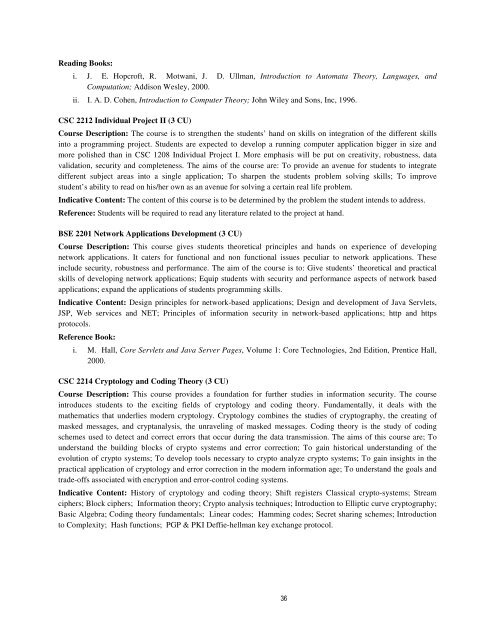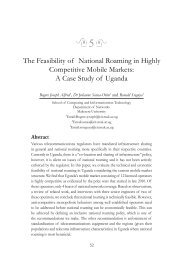Undergraduate Handbook - School of Computing and Informatics ...
Undergraduate Handbook - School of Computing and Informatics ...
Undergraduate Handbook - School of Computing and Informatics ...
You also want an ePaper? Increase the reach of your titles
YUMPU automatically turns print PDFs into web optimized ePapers that Google loves.
Reading Books:<br />
i. J. E. Hopcr<strong>of</strong>t, R. Motwani, J. D. Ullman, Introduction to Automata Theory, Languages, <strong>and</strong><br />
Computation; Addison Wesley, 2000.<br />
ii. I. A. D. Cohen, Introduction to Computer Theory; John Wiley <strong>and</strong> Sons, Inc, 1996.<br />
CSC 2212 Individual Project II (3 CU)<br />
Course Description: The course is to strengthen the students’ h<strong>and</strong> on skills on integration <strong>of</strong> the different skills<br />
into a programming project. Students are expected to develop a running computer application bigger in size <strong>and</strong><br />
more polished than in CSC 1208 Individual Project I. More emphasis will be put on creativity, robustness, data<br />
validation, security <strong>and</strong> completeness. The aims <strong>of</strong> the course are: To provide an avenue for students to integrate<br />
different subject areas into a single application; To sharpen the students problem solving skills; To improve<br />
student’s ability to read on his/her own as an avenue for solving a certain real life problem.<br />
Indicative Content: The content <strong>of</strong> this course is to be determined by the problem the student intends to address.<br />
Reference: Students will be required to read any literature related to the project at h<strong>and</strong>.<br />
BSE 2201 Network Applications Development (3 CU)<br />
Course Description: This course gives students theoretical principles <strong>and</strong> h<strong>and</strong>s on experience <strong>of</strong> developing<br />
network applications. It caters for functional <strong>and</strong> non functional issues peculiar to network applications. These<br />
include security, robustness <strong>and</strong> performance. The aim <strong>of</strong> the course is to: Give students’ theoretical <strong>and</strong> practical<br />
skills <strong>of</strong> developing network applications; Equip students with security <strong>and</strong> performance aspects <strong>of</strong> network based<br />
applications; exp<strong>and</strong> the applications <strong>of</strong> students programming skills.<br />
Indicative Content: Design principles for network-based applications; Design <strong>and</strong> development <strong>of</strong> Java Servlets,<br />
JSP, Web services <strong>and</strong> NET; Principles <strong>of</strong> information security in network-based applications; http <strong>and</strong> https<br />
protocols.<br />
Reference Book:<br />
i. M. Hall, Core Servlets <strong>and</strong> Java Server Pages, Volume 1: Core Technologies, 2nd Edition, Prentice Hall,<br />
2000.<br />
CSC 2214 Cryptology <strong>and</strong> Coding Theory (3 CU)<br />
Course Description: This course provides a foundation for further studies in information security. The course<br />
introduces students to the exciting fields <strong>of</strong> cryptology <strong>and</strong> coding theory. Fundamentally, it deals with the<br />
mathematics that underlies modern cryptology. Cryptology combines the studies <strong>of</strong> cryptography, the creating <strong>of</strong><br />
masked messages, <strong>and</strong> cryptanalysis, the unraveling <strong>of</strong> masked messages. Coding theory is the study <strong>of</strong> coding<br />
schemes used to detect <strong>and</strong> correct errors that occur during the data transmission. The aims <strong>of</strong> this course are; To<br />
underst<strong>and</strong> the building blocks <strong>of</strong> crypto systems <strong>and</strong> error correction; To gain historical underst<strong>and</strong>ing <strong>of</strong> the<br />
evolution <strong>of</strong> crypto systems; To develop tools necessary to crypto analyze crypto systems; To gain insights in the<br />
practical application <strong>of</strong> cryptology <strong>and</strong> error correction in the modern information age; To underst<strong>and</strong> the goals <strong>and</strong><br />
trade-<strong>of</strong>fs associated with encryption <strong>and</strong> error-control coding systems.<br />
Indicative Content: History <strong>of</strong> cryptology <strong>and</strong> coding theory; Shift registers Classical crypto-systems; Stream<br />
ciphers; Block ciphers; Information theory; Crypto analysis techniques; Introduction to Elliptic curve cryptography;<br />
Basic Algebra; Coding theory fundamentals; Linear codes; Hamming codes; Secret sharing schemes; Introduction<br />
to Complexity; Hash functions; PGP & PKI Deffie-hellman key exchange protocol.<br />
36

















